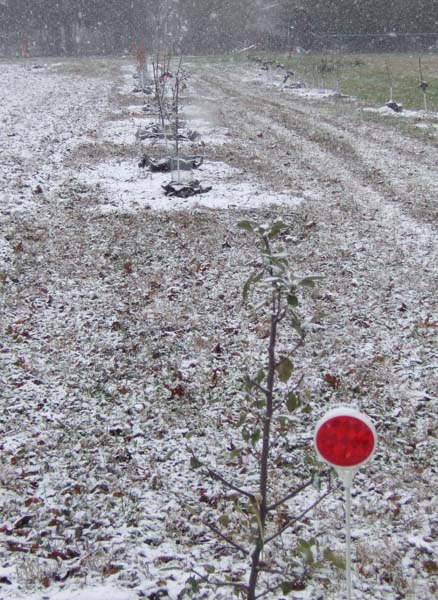Normally one doesn't give a lot of thought to walking over to the thermostat and spinning the dial to change the temperature, but hopefully, someone long before figured out how much heat would need to be available to satisfy that request - even when it is something like 14 below 0F outside. The difference between the coldest outside temperature and warmest inside temperature for a heating system is then something like 80F - from -14F to 66F. That 80 degrees is called the Design Temperature Difference (DTD.) Through the end of the summer, while the orchard was soaking up sun and water, yours truely was giving a lot of thought to the DTD not to mention everything else about the heating system, as after Labour Day everything between the thermostat and cast iron radiators was removed from the house as the post-war (WWII) oil-fired boiler and possibly older iron pipe, was upgraded to a modern Natural Gas-fired boiler and controls. Somewhere in there were calculations about how much heat was put out by the old system (given the size of the cast iron radiators and operating temperature), the probable heat lost of the mostly under or un-insulated house, as well as the potential heat dissipation of all the fixtures (existing and proposed.) Now that thinking's been done, in that early morning haze I wake up to a slightly warmer house thanks to the programmable thermostat, all I need do is find my slippers and can wander off to let the dogs out and then can wander into a bathroom which is 10 degrees warmer than the rest of the house, thanks to these wonderful little devices called thermostatic regulating valves.
Friday, January 16, 2009
Design Temperature Difference
We've finally hit that portion of the New England Winter where the temperatures drop down below 20F and when one again experiences something about the thawing temperature water it seems wonderfully warm, even when accompanied by snow. The snow underfoot squeaks when you tread upon it - volume and pitch increasing as the mercury decreases. The northern portion of the deck, deprived of sun in the summer, is coated with ice from the previous freezing rain a week ago. The boards no longer bend or squeak but sound as gunshots when the ice fractures allowing them to move independent of their neighbors. Meanwhile, inside, any bits of water in the air can now be found condensing on the lower edges of the upper window sashes. Spare those two small windows, where the outer edge has gone to frost not to mention the storm door which even yesterday's mild +8F temperatures only had condensation, today is fully frosted. The dogs are less eager to go out and quick to return. The weather station recorded a low just past -9F while another sensor shielded from ground radiation reported a low of -14F in pre-dawn hours.
Subscribe to:
Post Comments (Atom)

When I mentioned how low it was here overnight Kenny said I might have just lost all my Peach trees.. Wikipedia's entry on plant zones indicates that it is not out of bounds for zone five. Time will tell
ReplyDelete